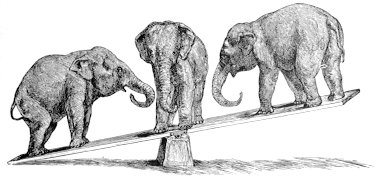The Tipping Point
Today, a thought about math education, parents, and the camel's back. The University of Houston's College of Engineering presents this series about the machines that make our civilization run, and the people whose ingenuity created them.
Crises don't reach us step-by-step. They arrive all at once. The camel seems comfortable under his load until we add just one straw too many. Writer Malcom Gladwell talks about tipping points in human affairs. A heavy kid sits on one end of a teeter-totter. He holds a skinny kid hostage at the other end -- up in the air. As the skinny kid's friends hand him one brick at a time, nothing happens. Finally one last brick and the heavy kid rises helplessly. The tipping point has been reached. It's his turn to be a hostage.
The math we learned in school prepared us to expect linear behavior in the world around us. We expect things to be proportional to one another. Hand the skinny kid one brick and the heavy kid should rise an inch, shouldn't he? Well, that's not how life is.
Look at disease, says Gladwell. Imagine a 24-hour flu going around. There's one chance in 50 a sick person will transmit it when he meets a well person. If he meets 45 people a day the disease dies out. But at Christmastime our sick person meets 55 people a day -- on the bus and in the malls. Now we face an epidemic.
Gladwell's most startling example is crime in New York City. Not too many years ago, many people thought the city was doomed. Crime rates were alarmingly high. Today, in a short time, violent crime in New York City has dropped to number 36 among major American cities. It's now on a level with Boise, Idaho. What happened?
Chief of Police William Bratton made a few seemingly small changes. He put a few more foot police in bad neighborhoods, cracked down on minor dope peddlers, rousted loiterers. He recognized what crime has in common with disease. Both are contagious.
A Stanford psychologist did a telling experiment. He parked two cars in a bad neighborhood: one in good condition, the other with no plates and the hood open. Soon everything of value had been stolen from the ratty car. The clean car was untouched. Ratty environments evoke ratty behavior. Crime really is contagious. To achieve remission Bratton reduced contact with the disease.
We face our own tipping point in education. Public school students come to universities with poorer and poorer math preparation. In math-based colleges like engineering, science, and business we've suddenly reached a point were we must choose between an alarmingly high failure rate or an alarming lowering of standards.
Maybe in this case we can recognize a nonlinear tipping point and do something about it. The tipping point is parental interest. Gladwell quotes more data: at a certain point, a tiny decrease in the number of parents who value education can cause education in a school to suffer terribly. Parents tip the balance in our schools. To empower our children with a knowledge of math and science we must convince just a few parents. It takes only a few to tip the balance, and do great good.
I'm John Lienhard, at the University of Houston, where we're interested in the way inventive minds work.
(Theme music)
Gladwell, M. The Tipping Point. New Yorker, June 3, 1996, pp. 31ff.
I am grateful to UH Chancellor William Hobby for drawing my attention to the tipping-point idea and for providing a copy of Gladwell's article.
